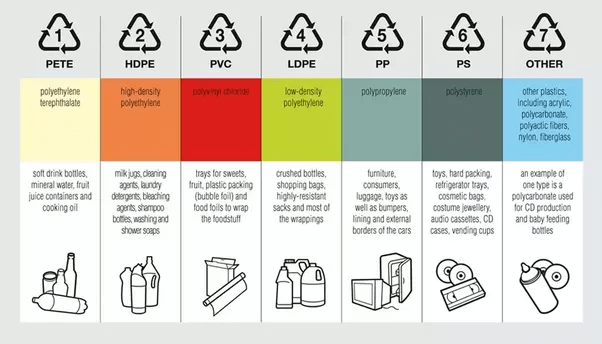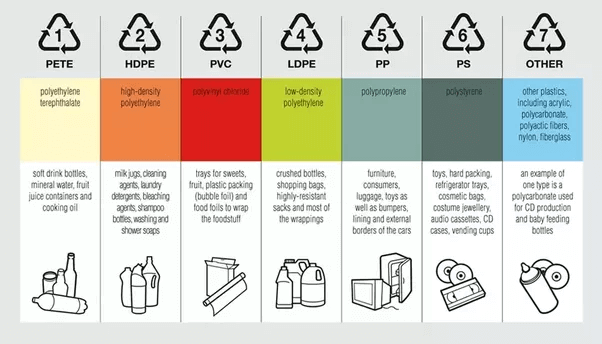Since the 1950s, the production of plastic has outpaced that of almost every other material. Plastic is an essential component of many items, including water bottles, combs, and beverage containers. Television, computer, car, house, refrigerator, and many other essential products utilize plastic materials to make our life easier and more straightforward. This post makes an attempt to classify & differentiate these commonly used & popular types of plastic.
Basic Categories of Plastic
Plastics can be divided into two major categories:
A. Thermoplastics
- Thermoplastics can soften upon heating and return to their original form.
- These are less rigid than thermosets and are easily molded and extruded into films, fibers and packaging.
- Examples include polyethylene (PE), polypropylene (PP) and polyvinyl chloride (PVC).
B. Thermoset or thermosetting plastics.
- Once cooled and hardened, these plastics retain their shapes and cannot return to their original form.
- They are hard and durable.
- Thermosets can be used for auto parts, aircraft parts and tires.
- Examples include polyurethanes, polyesters, epoxy resins and phenolic resins.
Types of Plastic
Polyethylene Terephthalate (PETE or PET)
- Polyethylene Terephthalate or PET is an aromatic polyester (because it contains both carboxylic and benzene groups).
- It is prepared in a reaction between ethylene glycol and either Terephthalic acid or the dimethyl ester of Terephthalic acid.
Polyvinyl Chloride (PVC):
- PVC is made from oil and salt.
- The oil is ‘cracked’ to produce ethylene, and the salt is processed to produce chlorine. The two products are then combined to produce ethylene dichloride, which is further processed to produce the monomer vinyl chloride. This is then polymerised to make polyvinyl chloride (PVC).
- PVC is thermally unstable, so stabilisers and lubricants are added in a compounding process. This produces rigid PVC (often referred to as unplasticized PVC or PVC-U). Flexible PVC is made with the addition of plasticisers.
Polypropylene (PP)
- Polypropylene is made by polymerising Propylene.
- In 1953, Karl Ziegler and Giulio Natta, working independently, prepared polypropylene from propylene monomers (CH2=CHCH3) and received the Nobel Prize in Chemistry in 1963.
- The various forms of polypropylene have different melting points and harnesses.
- Polypropylene is used in car trim, battery cases, bottles, tubes, filaments and bags.
Polystyrene or Styrofoam (PS)
- Polystyrene (Styrofoam): Polystyrene is formed by styrene molecules. The double bond between the CH2 and CH parts of the molecule rearranges to form a bond with adjacent styrene molecules, thereby producing polystyrene.
- It can form a hard impact-resistant plastic for furniture, cabinets (for computer monitors and TVs), glasses and utensils.
Polyethylene
- The most common polymer in plastics is polyethylene, which is made from ethylene monomers (CH2=CH2). The first polyethylene was made in 1934. Today, we call it low-density polyethylene (LDPE) because it will float in a mixture of alcohol and water.
Low-Density Polyethylene (LDPE):
- In LDPE, the polymer strands are entangled and loosely organized, so it’s soft and flexible.
- It was first used to insulate electrical wires, but today it’s used in films, wraps, bottles, disposable gloves and garbage bags.
High-Density Polyethylene (HDPE) :
- In the 1950s, Karl Ziegler polymerized ethylene in the presence of various metals. The resulting polyethylene polymer was composed of mostly linear polymers. This linear form produced tighter, denser, more organized structures and is now called high-density polyethylene (HDPE).
- HDPE is a harder plastic with a higher melting point than LDPE, and it sinks in an alcohol-water mixture.
- HDPE was first introduced in the hula hoop, but today it’s mostly used in containers.
Types of Plastic & Their Applications:
A. Thermoplastics:
| Types of Plastic | Applications |
| PET | Bottles, film, food packaging, synthetic insulation |
| Polypropylene | Film, battery cases, microwave containers, crates, car parts, electrical components. |
| Polystyrene | Electrical appliances, thermal insulation, tape cassettes, cups, plates |
| PVC | Window frames, pipes, flooring, wallpaper, bottles, cling film, toys, guttering, cable insulation, credit cards, medical products. |
| LDPE | Film, bags, toys, coatings, containers, pipes, cable insulation. |
| HDPE | Containers, toys, house wares, industrial wrapping and film, gas pipes. |
| Acrylonitrile-Butadiene-Styrene(SAN/ABS) | Transparent all-weather sheet, electrical insulators, domestic appliances |
| Polyamide | Films for packaging of foods such as oil, cheese and boil-in-the-bag products and for high temperature engineering applications. |
| Polymethyl methacrylate (PMMA) | General appliance mouldings. |
B. Thermosetting Plastics:
| Types of Plastic | Applications: |
| Epoxy resins | Adhesives, car components, components, sports equipment’s, boats. |
| Polyurethane | Adhesives, appliances, car parts, electrical components, trainer soles, furniture foam |
| Phenolic (phenol formaldehyde, urea formaldehyde) | Adhesives, appliances, car parts, electrical |
| Furan Resins | Manufacture of sustainable bio composite construction, cements, adhesives, coatings and casting/foundry resins. |
Types of Plastic & Their Recycle Codes:
In 1988, the Society of the Plastics Industry (SPI) established a classification system to help people properly recycle and dispose of their plastics. Today, manufacturers follow this coding system and place a number, or SPI code, on each product, usually molded into the bottom.

Credits – Prakati



